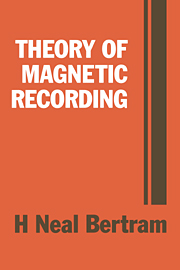Book contents
- Frontmatter
- Contents
- Preface
- 1 Overview
- 2 Review of magnetostatic fields
- 3 Inductive head fields
- 4 Medium magnetic fields
- 5 Playback process: Part 1 – General concepts and single transitions
- 6 Playback process: Part 2 – Multiple transitions
- 7 Magnetoresistive heads
- 8 Record process: Part 1 – Transition models
- 9 Record process: Part 2 – Non-linearities and overwrite
- 10 Medium noise mechanisms: Part 1 – General concepts, modulation noise
- 11 Medium noise mechanisms: Part 2 – Particulate noise
- 12 Medium noise mechanisms: Part 3 – Transition noise
- References and bibliography
- Index
8 - Record process: Part 1 – Transition models
Published online by Cambridge University Press: 02 February 2010
- Frontmatter
- Contents
- Preface
- 1 Overview
- 2 Review of magnetostatic fields
- 3 Inductive head fields
- 4 Medium magnetic fields
- 5 Playback process: Part 1 – General concepts and single transitions
- 6 Playback process: Part 2 – Multiple transitions
- 7 Magnetoresistive heads
- 8 Record process: Part 1 – Transition models
- 9 Record process: Part 2 – Non-linearities and overwrite
- 10 Medium noise mechanisms: Part 1 – General concepts, modulation noise
- 11 Medium noise mechanisms: Part 2 – Particulate noise
- 12 Medium noise mechanisms: Part 3 – Transition noise
- References and bibliography
- Index
Summary
Introduction
In this chapter, models will be discussed that give insight into the recording process. In contrast to the playback process, the recording of magnetization patterns is a non-linear phenomenon. Thus, except for special cases, analysis must be by computer simulation. It is the long-range magnetostatic fields that cause computer simulations to be iterative and extremely time consuming. There are two philosophical approaches to computations of the record process. One is to neglect the fine details and develop reasonably approximate models that capture the main physical features of the process. Such simplified models allow for analytic solutions of magnetization patterns or solutions that require a minimum of computer simulation. This simplified approach is useful for developing guidelines in media development (e.g. the effect of coercivity or remanence changes) or in head–media interface geometry development (effect of head–medium spacing, record gap, medium thickness). Parameters can be easily changed in simplified models.
The other approach is to develop full numerical micromagnetic models. These are required in order to compute detailed, or second order effects, of the recording process, such as noise, edge-track writing, and non-linear amplitude loss and thus, for example, give fundamental input to error-rate calculations. Simulations can give detailed information about pulse asymmetry in tape recording (Bertram, et al., 1992) or the fluctuations of the transition center across the track that leads to position jitter or transition noise in thin film media (Zhu, 1992). For example, in Fig. 8.1 the vector magnetization distribution from micromagnetic simulation of a recorded transition in thin film media is shown.
- Type
- Chapter
- Information
- Theory of Magnetic Recording , pp. 205 - 244Publisher: Cambridge University PressPrint publication year: 1994
- 1
- Cited by



